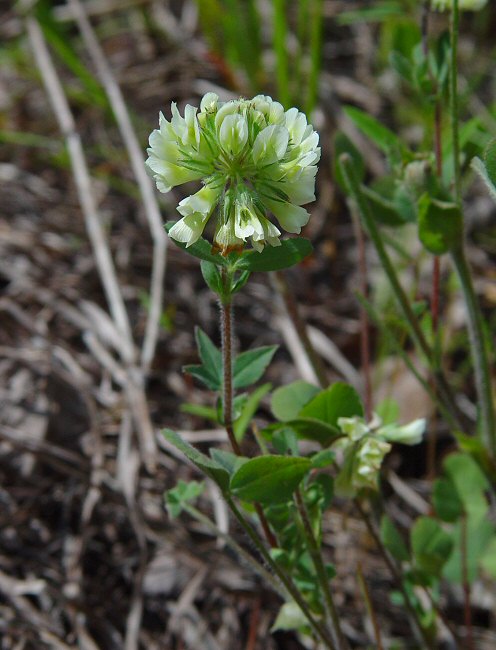Trifolium reflexum L.
Buffalo Clover

Native
CC = 8
CW = 5
MOC = 55
© DETenaglia
Trifolium reflexum L.Buffalo Clover | |
 |
Native CC = 8 CW = 5 MOC = 55 |
© DETenaglia |
|
Family - Fabaceae/Faboideae Habit - Taprooted annual or biennial forb. Stems - Loosely to strongly ascending, to 50 cm, not rooting at the lower nodes, unbranched or few branched toward the base, glabrous to densely short-hairy, sometimes purple in strong sun.
Leaves - Alternate, trifoliolate, stipulate, long-petiolate toward the stem base, somewhat reduced toward the tip, the longest petioles to 65 mm long, 3-4 times as long as the leaflets. Stipules to 2 cm long, shorter than the associated petiole, broadly ovate, fused nearly to the midpoint and somewhat sheathing the stem, the free portions angled or tapered at the tips, herbaceous and leaflike, the margins entire or toothed. Petioles pilose, to 10 cm long. Leaflets 10-30 mm long, 6-20 mm wide, all sessile or nearly so, ovate to obovate, angled at the base, broadly rounded to sharply pointed at the tip, the margins sharply toothed.
Inflorescences - Terminal dense globose umbels 20-35 mm long and wide, the stalk 20-60 mm long. Flowers 10-40, the stalk 4-8 mm long at flowering, elongating to 7-12 mm and becoming sharply reflexed at fruiting.
Flowers - Calyces 4-9 mm long, the tube 1.0-1.5 mm long, glabrous to densely hairy, the teeth narrowly triangular to linear, 3-5 times as long as the tube, nearly equal. Corolla papilionaceous, 8-14 mm long, longer than the calyx lobes, white to cream-colored or occasionally deep pink, the banner outcurved, 8-10 mm long, 4-5 mm broad, oblong to elliptic, bluntly and broadly pointed to rounded or shallowly notched at the tip and with an entire or more commonly somewhat irregular margin, finely but relatively strongly parallel-nerved with age. Wings and keels to 7-8 mm long. Wings connate to the keels at about the middle. Stamens diadelphous. Stamen tube white, to 3 mm long, glabrous. Free portion of the filaments to 3 mm long and deflexed. Anthers yellow, to 1 mm long. Ovary superior, green, 3 mm long, mostly glabrous but with white floccose hairs at the apex, slightly compressed. Style 3 mm long, greenish-white, glabrous, deflexed at the apex. Stigma small, capitate, yellowish. Corolla drying brown and persistent around the developing fruit.
Fruits - Legumes, 3-5 mm, ovoid to oblong-obovoid, minutely stalked, (1)2-4-seeded. Seeds 1.0-1.5 mm long, more or less globose, pale yellow, sometimes with darker mottling, dull and finely pebbled.
Flowering - May - August. Habitat - Upland prairies, glades, forest openings, savannas, streambanks, pond margins, pastures, roadsides. Typically on acid soils. Origin - Native to U.S. Other info. - This species can be found throughout much of Missouri, though it is apparently rare in the northwestern third of the state. The plant is fairly easy to identify in the field because of its unusually large flower heads. As the heads age, the flower stalks arch downward and create a distinctive crownlike appearance. Photographs taken near Stegal Mountain, Shannon County, MO., 6-4-04 (DETenaglia); also in the Ouachita National Forest, Montgomery County, AR, 5-7-2015 (SRTurner). |